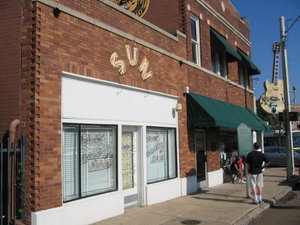Advertisement
Published: December 30th 2008
[youtube=WG9fs7qnBoY]

 The Sun Studios
The Sun Studios
It's still hard to fathom how much influentinal and important music was recorded in this small building in less than 10 years.”That’s All Right”, “Blue Moon of Kentucky”, and “Good Rockin’ Tonight” by Elvis Presley. Then go back and listen to Arthur “Big Boy’ Crudup’s original version of “That’s All Right”, Bill Monroe’s original 1940’s version of “Blue Moon of Kentucky”, and Wynonie Harris’ version of “Good Rockin’ Tonight”.
Suggested Food and Drink for this Entry: Although nearly the same meal was suggested for the Rock N Soul Museum, go with one of Elvis’ favorites, a cheeseburger, fries and milkshake.
With our Sun Studio tour continuing in the museum room above the actual studio, our tour guide hit the highlights of the studio’s blues and R&B days in the early 1950’s that included hearing snipets of “Bear Cat” and Howlin’ Wolf. Looking around the tour group, I could tell at least a few of folks could care less about Rufus Thomas and Howlin’ Wolf. Hell, some of those people had probably never heard of Thomas and the Wolf. Those folks were there see the place where Elvis Presley “invented” rock and roll and, if they heard a little Jerry Lee Lewis or Johnny Cash, so be it. As I mentioned in my first entry on Sun

 One of the Original Microphones
One of the Original Microphones
from the Sun Studio. Or, at least that's what they claim.Studios, our tour guide did a great job balancing the tour for the varying amount of knowledge among the group. After hearing about most of the displays in the small museum, we headed down to the actual studio where a timid eighteen year old truck driver made his first recording in the summer of 1953.
Legend has it Elvis Presley walked into the Sun Studios in mid 1953 to record a personal record to give to his mother as a birthday gift and, a little over a year later, “invented” rock and roll in a late night recording session. (Many historians have since debunked the gift legend because Elvis’ mother’s birthday was in the spring. And obviously, no one person invented rock and roll.) The amount of time Elvis spent at the Sun Studio between the time of that personal recording and the time his first Sun record, “That’s All Right” and “Blue Moon of Kentucky”, was released in July 1954 is unclear now over fifty years later. What is clear is that sometime within that time frame, Phillips teamed Elvis with guitarist Scotty Moore and bass player Bill Black and Elvis morphed from a timid teenager into a

 Elvis' High School Diploma
Elvis' High School Diploma
is on display in the small museum that is part of the Sun Studio tour.an assertive performer.
In the first half of 1954, the trio of Presley, Moore and Black was playing live around Memphis and making occasional forays into the Sun Studio in an attempt to record something Sam Phillips deemed marketable. During one of these recording sessions, Presley was attempting a version of the country standard “I Love You Because”. After failing to get an acceptable version of that song, the band took a break. The legend continues from there telling us that during the break, Elvis began fooling around with a hyped up version bluesman Arthur “Big Boy” Crudup’s 1947 release “That’s All Right”. Elvis’ performance of the song caught Sam Phillip’s attention and fit into what Phillips claimed years later he was looking for in a white singer who performed with a “negro feel”. A short time later, the trio recorded an up-tempo version of the Bill Monroe’s bluegrass classic “Blue Moon of Kentucky”. (Please see watch the video attached to this entry which is Sam Phillips telling the Sun story in his own words.)
Much has been made of this session and Elvis’ first commercially released record which came from the session. Some claim the session and the record was the birth of rock and roll. Others claim the session and record merely represents the day white performers copying and began ripping off the black blues and R&B performers’ styles and music. Neither of these beliefs could be further from the truth.
Like many white teenagers at the time, Elvis was listening to the “race” records being played on stations such as WDIA in Memphis. More adventurous white teenagers were sneaking off to see the R&B performers of the day or getting exposed to local blues performers in small southern towns or at juke joints. The white singers and musicians who truly became rock and roll artists during this era were obviously heavily influenced by the blues and R&B they heard. These white artists held these blues and R&B performers in just as high regard as they held the country performers of the time. And, this is obviously the case with Elvis Presley, whose first record featured vastly different from the original versions of both a blues song and a bluegrass song. Elvis’ version of “That’s All Right” featured a more driving beat and a vocal that carried quite a charge in comparison to Crudup’s original. Elvis’ version of “Blue Moon Kentucky” was a total reworking of Bill Monroe’s original recording, which was slow and in a waltz tempo. Elvis’ version was up tempo throughout and featured a more driving bass line than anything Monroe recorded.
Shortly after the recording session that produced Elvis’ first release, Sam Phillips distributed copies of the record to a few DJs in Memphis. One of these DJs, Dewey Phillips (no relation to Sam) at WHBQ, immediately jumped on the record and drove the demand for the record around the mid-south. During the Sun Studios tour, a sound clip is played of Dewey Phillips introducing “That’s All Right” the first time the song was played on Phillips’
Red, Hot & Blue radio program. After releasing the record on July 19, 1954, Sam Phillips began searching for ways to get Elvis exposed to the public. The first appearance where Elvis the singer met Elvis the rock and roll artist supposedly happened on July 30, 1954 when Elvis opened a show for Slim Whitman in Memphis. Reportedly, this was the first time Elvis gyrated on stage while singing. The question as to whether Elvis’ movements were driven by nerves or whether they were planned has never has been answered. (Many who knew R&B singer Wynonie Harris, including record producer Ralph Bass, have claimed Elvis’ stage antics were a direct imitation of Harris.) But either way, this was the first known appearance where the crowd went crazy over Elvis.
In September 1954, Sun released Elvis’ second record which consisted of an even more odd pairing of songs than Elvis’ first release. The A side was a cover of “Good Rockin’ Tonight”, a song written by R&B singer Roy Brown and recorded by both Brown and Wynonie Harris. Both the earlier versions of the thinly veiled tribute to getting busy behind the barn were horn driven jump blues numbers (think a more driving version of swing). Elvis’ version was a stripped down, slightly slower three instrument version of the song. The B side of the record was “I Don’t Care if the Sun Don’t Shine”, a song from the Disney movie
Cinderella that had been recorded by both Patti Page and Dean Martin.
As influential as Elvis’ first Sun recordings were, the truth is they did not sell massive amount records at the time. By the fall of 1954, the first single, “That’s All Right” and “Blue Moon of Kentucky”, had sold around 25,000 copies and the second single had sold around 20,000 copies.
But with this exposure, Elvis was invited to make an appearance on the Grand Ole Opry in October 1954. Legend has it, Elvis was a total flop and that Opry manager Jim Denny told Elvis to “go back to driving a truck”. The lone bright spot of the evening was when Bill Monroe, who was known to be “difficult” at times, told Elvis he approved of Elvis’ version of “Blue Moon of Kentucky” after Elvis apologized to him for changing the song so drastically.
Over the next year, Elvis’ momentum began to grow as Sun continued to release singles, Elvis toured the South and Elvis made regular appearances on the Louisiana Hayride which, at the time, was a live performance radio show that was broadcast across the South that was in competition with the Grand Ole Opry. In early 1955, Colonel Tom Parker appeared in the scene to become Presley’s booking agent. Soon afterward, Parker began to believe he could break Presley beyond the South and Presley made Parker his manager (an arrangement that lasted until Elvis’ death in 1977).
Soon, the Colonel was looking to move Elvis’ recording contract from Sun to a larger, national record company. By the fall of 1955, Phillips was feeling the cash flow pressure of trying to keep enough records in the sale pipeline for two artists, Elvis and the recently arrived Johnny Cash. In November 1955, Phillips sold Presley’s recording contract to RCA for $35,000. Looking back, this may sound like a poor decision. But at the time, Phillips was pressed for cash and the time remaining on Elvis’ contract was winding down. Much like when a struggling baseball team has one star player who is about to be lost to free agency, Phillips traded his star for a prospect. In this case, the prospect was the cash that would keep Phillips and Sun in business and allow Phillips to record the many other artists who were beginning to make their way to Sun’s Union Avenue studios.
So, Elvis Presley left Sun at the end of 1955. He would never again officially record at the Sun Studios…….
A couple of footnotes on the birth of rock and roll… While Elvis was trying to get the “negro feel”, as Sam Phillips put it, or just trying to rip off blues artists as other think in 1955, a black man from St. Louis was attacking rock and roll from the opposite direction. Chuck Berry’s rock classic “Maybellene” was based directly on the old country song, “Ida Red”. Funny how Elvis’ critics never seem to mention that.
Shortly after Elvis' version of "Blue Moon of Kentucky" was released, Bill Monroe re-recorded the song. This version began with the first verse and chorus being in the same waltz tempo as his original version, then the song goes into an up tempo beat similar to that used in Elvis' version. Monroe continued to perfmorm the song in that manner until his death in the 1990's.
Advertisement
Tot: 0.125s; Tpl: 0.011s; cc: 6; qc: 43; dbt: 0.0831s; 1; m:domysql w:travelblog (10.17.0.13); sld: 1;
; mem: 1.1mb









